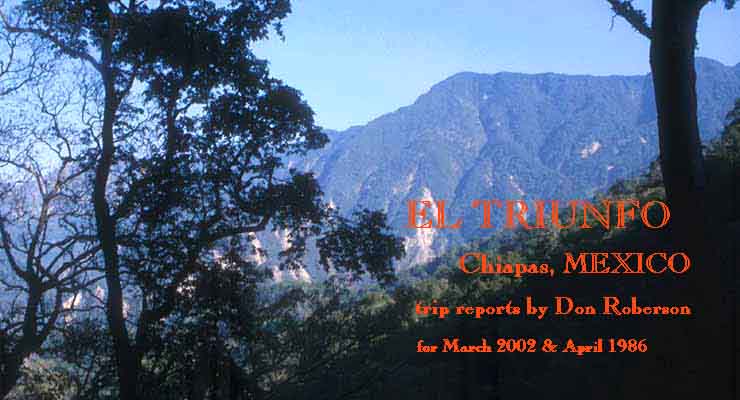

El Triunfo is one of the most remote places one can reach in the Neotropics. It is a beautiful cloud forest on the continental divide high in the Sierra Madre de Chiapas, Mexico (and very near the Guatemala border). It is either a three-day, 22 mile hike gaining over 6000' in elevation up the Pacific slope (as we did in April 1986), or a one-day, 8 mile climb of 2400' elevation from the east side (as we did in March 2002). Either expedition is a physical challenge but the rewards are astonishing. The colors and contrasts of the life zones one traverses, and the beauty and mystery of the birds and wildlife encountered, are breathtaking. Here is just one collage of contrasts in color and shape:
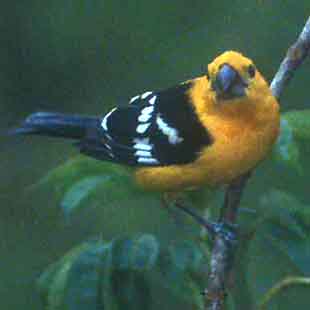 |
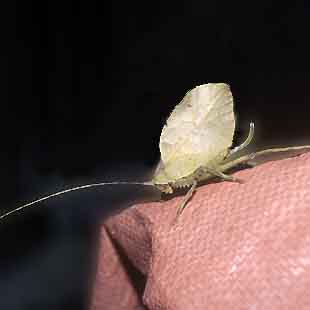 |
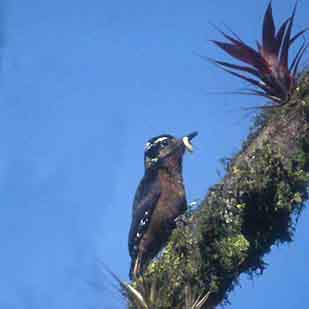 |
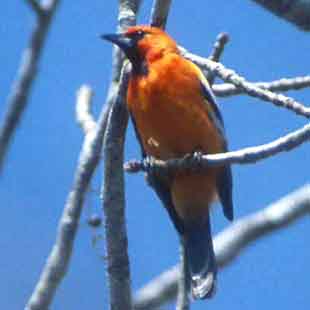 |
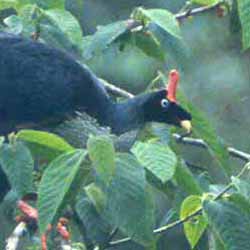
El Triunfo is best known as holding the world's largest concentration of Horned Guan, a huge, dramatic, and endangered cracid whose entire world range is restricted to isolated cloud forests in Chiapas and adjacent Guatemala. I have an entire Horned Guan page devoted to this near-mythical guan.
I first visited El Triunfo in 1986 when I was young and energetic
(below; top left), and then again in 2002 when I was worn-out and pushing
50 (below; top right). Fortunately, Victor Emanuel did not change
from 1986 (below with Don Rodrigo, bottom left) to today (below
with
Ismael Valdez-Valdez, bottom right).
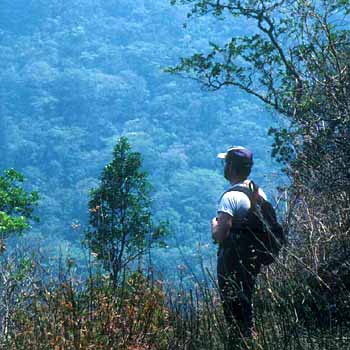 |
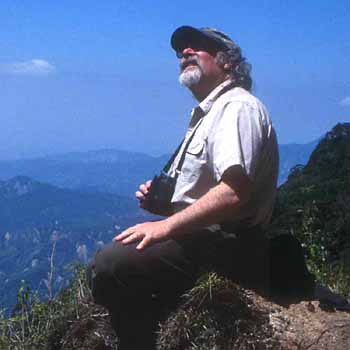 |
 |
 |


The trail is beautiful but long and physically challenging. During
the storms of fall 1998, many portions were washed out but have been rebuilt
by the local horseman. One such new traverse, on the Pacific side above
Canyon Honda, is shown above in a 2002 photo. There is a particularly
interesting long run down a ridge (right in a 1986 photo), through
oak woodands, where the path is worn deep by decades of use. This is the
only cross-Sierra route in southern Chiapas and is used by local villagers
to work the coffee farms to the east.
The birders carry only backpacks with water & lunch, and camera gear; horses carry all the camping equipment and ten days worth of meals. Don Rodrigo is no longer with us but his sons and relatives carry on the business. Inocente (above) is now in charge in this 2002 shot. Note he is trying our freeze-dried dinner package (just add hot water!) which now substitute for the fancier food we had back in '86. Inoncente thought it was okay but then he added a very liberal portion of pepper sauce....

 Those
making the Pacific side hike in 1986 included leaders Victor Emanuel &
Kevin Zimmer, plus Allan Keith, Wendy Paulson, Hugh & Kit Pratt, Karin
Bevolzheimer, and Bob & Gail Debellevue.
Those
making the Pacific side hike in 1986 included leaders Victor Emanuel &
Kevin Zimmer, plus Allan Keith, Wendy Paulson, Hugh & Kit Pratt, Karin
Bevolzheimer, and Bob & Gail Debellevue.
Co-leaders with Emanuel in 2002 were Brad Boyle (left; a little dazed after seeing our first Horned Guan) and Greg Lasley (right; note walkie-talkie in hand for subgroups to keep in touch with each other); tour participants were Susan Barbour & her mother Jane Low, Jerry Broadus & Clarice Clark, Larry Broeren, John Fitch, Jessica Jenner, Paul & Ursula Koldovsky, Kent Lannert, Greg Osland, Roy Rodwell and John Rothman.
On each trip, everyone was mellow and pleasant. This was a contrast
with some more-typical tours (which I generally try to avoid) when "difficult"
people are among the participants -- perhaps the fact everyone knew this
was an adventure with many difficulties that needed to be met and ovrcome
helped self-select-out the problem persons....
I have separate pages for the following trip elements:
|
hot, dry interior Chiapas (2002 only) |
|
hot, dry tropical scrub on Pacific slope |
|
deciduous oak forest on Pacific slope |
|
subtropical canyons at mid-elevation of Pacific slope |
|
wet & mossy montane woodland on Continental divide |
Each page features the habitat and birds of that elevation and ecological zone, plus some photos and stories of our visits. One very impressive feature of this cross-section of Chiapas -- especially if one visits it as we did in 2002 starting at interior Sumidero Canyon, liking to the cloud forest, and then down to Canyon Honda, Limonal, and Paval -- is that one can encounter five species of motmots. No where else on earth can this be accomplished. Some of them are exceptionally shy (especially Blue-throated & Tody Motmot) and tapes are very helpful; each has a distinctive voice that can dominant the aural landscape. The five are: Russet-crowned (interior dry woods only), Tody (lowland dry forest both slopes), Turquoise-browed (lowlands in open scrub, Pacific slope), Blue-crowned (low to mid elevations in deciduous woods), and Blue-throated (mid-elevations to cloud forest and very secretive). I managed to photograph three of these species on my two trips. These are (left to right) Blue-throated (below El Triunfo in 2002), Blue-crowned (above Paval in 1986), and Torquoise-browed (below Paval in 2002):
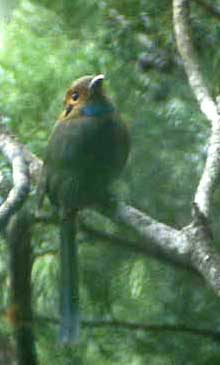

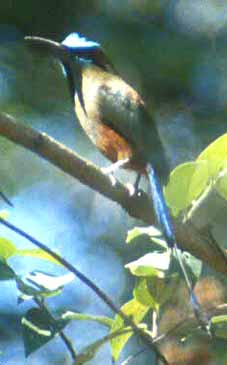
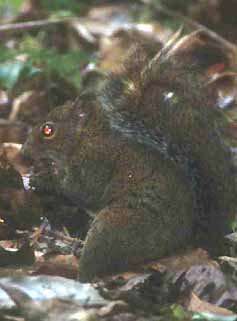 While
I am a passionate birder, I am also very interested in mammals and herps
(reptiles and amphibians). Photographed with a flash in the El Triunfo
forest (right) is a Deppe's Squirrel Sciurus deppei. Click
on the photo of the coral snake (below) to bring out a full page
on the herps of El Triunfo.
While
I am a passionate birder, I am also very interested in mammals and herps
(reptiles and amphibians). Photographed with a flash in the El Triunfo
forest (right) is a Deppe's Squirrel Sciurus deppei. Click
on the photo of the coral snake (below) to bring out a full page
on the herps of El Triunfo.
Finally, click on the button below for an annotated trip list that compares and contrasts 1986 and 2002. You can also find details of the avifauna in Gomez de Silva Garza et al. (1999), Howell (1999), and Parker et al. (1976). Andrle (1966) has an interesting photo of the El Triunfo clearing back in the 1960s.
|
birds, mammals & herps 1986 & 2002 |
You can reach Victor Emanuel Nature Tours at this link. I recommend doing the trip with them because of the logistics, the expertise of the guides and their tapes (very helpful with many shy and difficult birds, if not the Horned Guan), and mostly because VENT as done much over the last quarter century to promote protection of El Triunfo and solidify that protection by getting money into the local economy. Don Rodrigo has passed one but we met his widow in 2002 and his family continues to provide the horses annually for the El Triunfo adventure trek. However, it is possible to arrange your own trip through El Triunfo Biosphere Reserve and their ecotourism project. They can arrange pack animals and transport to the trailhead from Tuxtla Gutierrez. You will definitely want to visit in the dry season (January-June; March-April best) as the trails are essentially impassable during the rains. It can rain at any time but rains start about May and intensify July-October. The Reserve has recently posted an El Triunfo Biosphere web site (currently in Spanish only) with a variety of photos.
For another perspective, see Joelle Buffa's (2002) nice account of her experiences on VENT's March 2001 trip in the May/June 2002 issue of Bird-Watcher's Digest.
PHOTOS: All photos were taken during El Triunfo trips in Chiapas, Mexico, in April 1986 or March 2002. All are © 2002 Don Roberson, all rights reserved.
Literature cited:
Andrle, R. 1966. Horned Guan in Mexico and Guatemala. Condor 69: 93-109.TOPBuffa, J. 2002. Birding El Triunfo Biosphere Reserve: a tale of Horned Guans and horseman. Bird-Watcher's Digest 24: 98-107.
Gomez de Silva Garza, H., F. Gonzalez-Garcia, and M. P. Casillas-Trejo. 1999. Birds of the upper cloud forest of El Triunfo, Chiapas, Mexico. Ornith. Neotrop. 10: 1-26.
Howell, S.N.G. 1999. Where to Watch Birds in Mexico. Christopher Helm, London.
Parker, T. A. III, S. Hilty, and M. Robbins. 1976. Birds of El Triunfo cloud forest, Mexico, with notes on the Horned Guan and other species. Amer. Birds 30: 779-782.
Page created 2-8 Apr 2002, updated 17 May 2002